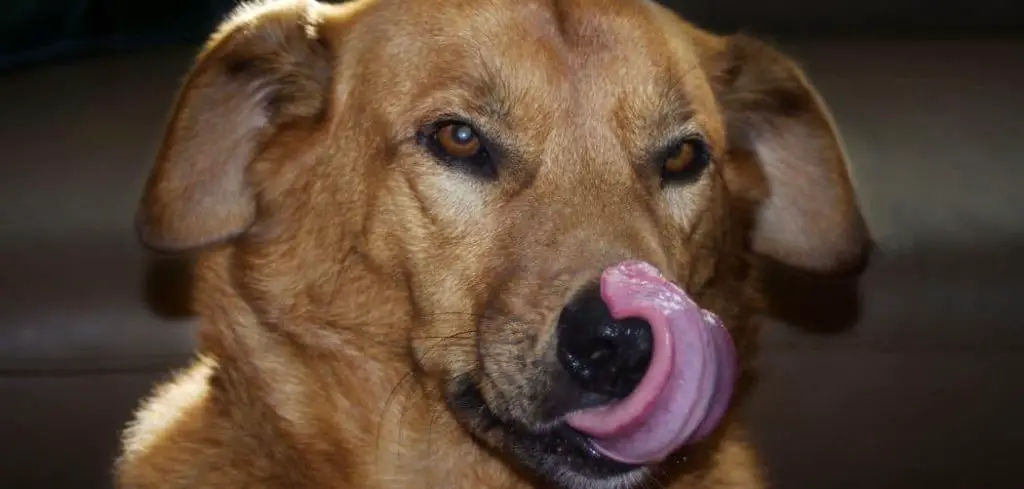Excessive licking of paws and legs in dogs can be alarming for owners, as it often signals discomfort, irritation, or behavioral issues.
While occasional grooming is normal, persistent licking that causes redness, hair loss, or sores is a sign that something may be wrong.
We outline the common reasons for a dog excessively licking their paws and legs, what you can do at home, and when to seek veterinary help.
Table of Contents
Dog Excessively Licking Paws and Legs — Why It Happens
A dog excessively licking their paws and legs is typically a response to irritation, discomfort, or behavioral triggers. Dogs may lick to soothe itchy skin caused by allergies, to clean wounds or foreign objects stuck in the paw, or as a coping mechanism for stress or boredom.
Environmental factors, such as chemicals on floors or rough outdoor surfaces, can also lead to repeated licking. Over time, this behavior can cause inflammation, secondary infections, and hair loss if left unaddressed.
Observing the frequency, intensity, and location of licking helps determine whether the cause is medical or behavioral.

Dog Excessively Licking Paws and Legs: Common Causes
Allergies
Allergies are one of the most frequent causes of paw and leg licking. Dogs with environmental or food allergies may experience itchy, inflamed skin, particularly on paws and lower legs.
Common signs include redness, swelling, recurring paw licking, and skin rashes. Allergic reactions can worsen if left untreated, leading to secondary bacterial or yeast infections that exacerbate discomfort.
Identifying and managing the allergen—through dietary changes, medications, or environmental adjustments—can significantly reduce licking behavior.
Read more: Dog Excessively Licking Back Paws (Why it happens)
Skin Infections
Bacterial or fungal infections can develop from wounds, scratches, or persistent moisture trapped between paw pads.
Dogs may lick affected areas to soothe irritation, which can actually worsen the infection over time.
Signs of infection include foul odor, redness, swelling, and discharge. Infections require veterinary evaluation for proper diagnosis and treatment, including antibiotics, antifungals, or medicated shampoos to prevent further complications.
Injuries and Foreign Objects
Cuts, splinters, thorns, or abrasions can cause a dog to lick paws excessively. Licking is a natural response to relieve discomfort or remove foreign materials from the skin.
You may notice limping, favoring one paw, or blood on the fur. Untreated injuries can lead to deeper infections or chronic irritation, so prompt examination and cleaning are essential.
Anxiety and Stress
Behavioral factors like anxiety, boredom, or separation stress can lead to repetitive licking. Dogs may lick paws and legs as a calming mechanism when feeling stressed or understimulated.
Signs include licking that occurs in conjunction with pacing, whining, or other repetitive behaviors.
Chronic anxiety can negatively impact overall health, so providing mental stimulation, consistent routines, and, if needed, professional behavioral guidance is important for management.
Parasites
Fleas, ticks, or mites can irritate the skin, leading dogs to lick excessively. Infestations often cause localized itching and hair loss on paws and legs. Other signs include visible parasites, small bite marks, redness, or scabs.
Parasite control and treatment are critical to prevent ongoing discomfort and the spread of infections or infestations.
Arthritis or Joint Pain
In older dogs, arthritis or joint pain may prompt licking of affected limbs. Dogs may focus on licking a paw or leg near a painful joint to soothe discomfort or draw attention to the area.
Signs include stiffness, reluctance to move, difficulty climbing stairs, or limping.
Veterinary assessment can provide pain management solutions and lifestyle adjustments to maintain mobility and reduce licking caused by discomfort.
What to Do If Your Dog Is Excessively Licking Their Paws and Legs
Observe your dog closely to determine whether licking is linked to medical issues or behavioral triggers. Keeping a record of when and how often the licking occurs can provide valuable insights.
Ensure paws and legs are clean and dry. Wash your dog’s feet after walks, especially if they have come into contact with dirt, chemicals, or allergens.
Drying thoroughly helps prevent irritation and infection caused by trapped moisture.
Provide safe chewing or licking alternatives. Using toys, treat puzzles, or approved chews can redirect licking caused by boredom or mild anxiety. Avoid punishing the dog, as this may worsen stress-related licking.
Monitor for signs of infection or injury. Redness, swelling, discharge, or persistent hair loss should prompt a veterinary visit. Early intervention prevents complications and accelerates healing.
Consider environmental and dietary adjustments. Switching to hypoallergenic foods, limiting exposure to irritants, and maintaining a clean home environment can reduce triggers that promote paw licking.
For behavioral causes, implement structured routines and mental enrichment. Regular walks, interactive play, and training exercises help manage anxiety and reduce repetitive licking behaviors.
When to Call or Visit Your Vet
Immediate veterinary attention is warranted if your dog’s licking is accompanied by bleeding, severe swelling, foul odor, or signs of systemic illness like lethargy, fever, or loss of appetite.
Persistent licking that does not improve with at-home care, or any licking causing open sores, should also prompt a veterinary visit.
Your veterinarian can assess for infections, allergies, injuries, parasites, or underlying medical conditions. Early evaluation allows for prompt treatment and prevents chronic complications.
Veterinary care may include diagnostic tests, topical or systemic medications, and professional advice for managing behavioral causes. Timely intervention ensures your dog remains comfortable and avoids worsening health issues.
Read more: Dog Licking Paws Excessively (What it means and what to do)
Key Takeaway
Excessive licking of paws and legs in dogs can stem from medical conditions, injuries, allergies, parasites, or behavioral issues like stress and boredom.
Observing your dog’s behavior, maintaining hygiene, and addressing environmental triggers are essential steps in managing this behavior.
Prompt veterinary evaluation is crucial if licking is persistent, severe, or accompanied by signs of infection or discomfort.
Combining attentive observation, preventive care, and professional guidance ensures your dog’s comfort, prevents complications, and promotes overall health and well-being.
Understanding the underlying cause allows you to take proactive steps to reduce excessive licking and improve your dog’s quality of life.
